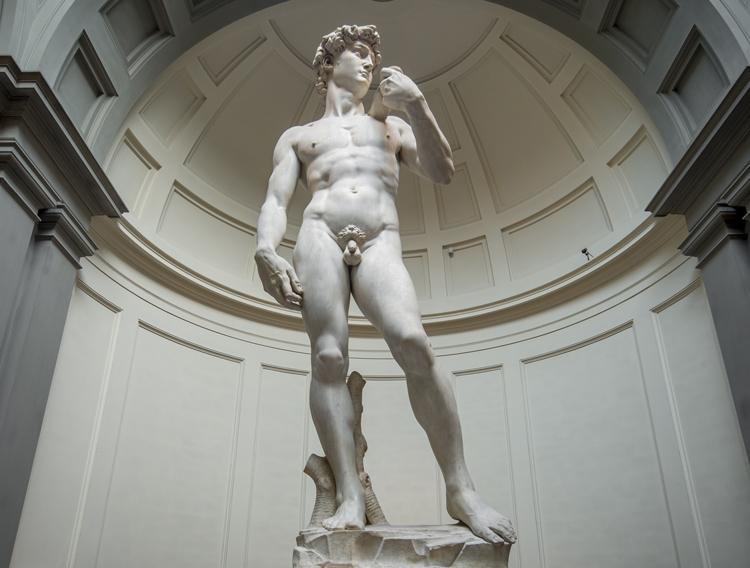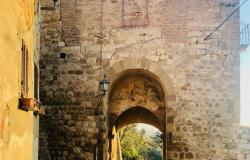The Story Behind Michelangelo’s David

The David, perhaps the world’s most famous sculpture, surely one of Florence’s greatest attractions, stands at 5.16 meters tall in the Accademia Gallery.
This outstanding sculpture was created between 1501 and 1504 by Renaissance genius Michelangelo, after the enormous block of marble used for the statue had lied abandoned for 25 years in the courtyard of the Opera del Duomo because the two artists originally commissioned with the work thought the marble, which came from the quarries in Carrara, had too many imperfections.
Michelangelo was hired to complete the project – the sculpture was to be one of a series of statues depicting Old Testament figures, to be placed in the buttresses of the Cathedral of Florence.
Michelangelo was 26 years old when he took on the task and worked on it for more than two years, creating a masterpiece that still leaves us in awe, more than 500 years after it was created.
His interpretation of the David is different from earlier versions by Florentine Renaissance artists, such as Verrocchio, Ghiberti and Donatello, who depicted a triumphant version of the young hero, standing victorious over Goliath’s severed head. Michelangelo chose to depict David before the battle: alert and ready for combat.
Michelangelo used the a classical pose known as contrapposto, where most of the weight is on one leg, so that the shoulders and arms twist off-axis from the hips and legs, giving the statue a more dynamic look.
You can hardly see the slingshot David carries over his shoulder, implying that David’s victory was due more to his cleverness than to his sheer force. His self-confidence and concentration are values that were highly regarded in the Renaissance, which strived toward the ideal of the “thinking man”.
When the statue was almost ready, Florentine authorities realized it was too large and heavy to be raised to the roof of the cathedral. In June 1504, David was placed next to the entrance to Palazzo Vecchio, where it replaced Donatello's bronze sculpture of Judith and Holofernes. It took four days to move the statue the half mile from Michelangelo's workshop to Piazza della Signoria.
In 1873, the statue of David was removed from the piazza to protect it from damage, and placed in the Accademia Gallery, where it can be admired today. The replica you see in Piazza della Signoria was installed in 1910, in the same spot where the original used to be.
Click here to buy the book that tells you the story of Michelangelo's David.
Il David, forse la scultura più famosa al mondo, sicuramente una delle più grandi attrazioni di Firenze, si trova, con i suoi imponenti 5,16 metri di altezza, nella Galleria dell'Accademia.
Questa eccezionale scultura fu creata tra il 1501 e il 1504 dal genio del Rinascimento Michelangelo, dopo che l'enorme blocco di marmo utilizzato per la statua aveva giaciuto abbandonato per 25 anni nel cortile dell'Opera del Duomo, perché i due artisti a cui era stato originariamente commissionato il lavoro avevano decretato che il marmo, proveniente dalle cave di Carrara, avesse troppe imperfezioni.
Michelangelo fu assunto per completare il progetto - la scultura doveva essere parte di una serie di statue raffiguranti figure dell'Antico Testamento, da posizionarsi nei contrafforti del Duomo di Firenze.
Michelangelo aveva 26 anni quando ottenne l’incarico e vi lavorò per più di due anni, creando un capolavoro che, più di 500 anni dopo la sua realizzazione, ci lascia ancora a bocca aperta.
La sua interpretazione del David è diversa rispetto alle versioni precedenti di artisti fiorentini del Rinascimento, come Verrocchio, Ghiberti e Donatello, i quali avevano raffigurato una versione trionfale del giovane eroe, in piedi vittorioso sulla testa mozzata di Golia. Michelangelo scelse di rappresentare David prima della battaglia: vigile e pronto per il combattimento.
Michelangelo utilizzò una posa del Classicismo nota come contrapposto: la maggior parte del peso è su una gamba, in modo che spalle e braccia si spostino fuori asse rispetto a fianchi e gambe, per dare alla statua un aspetto più dinamico.
La fionda che David porta sopra la spalla si intravede a fatica, per implicare il fatto che la vittoria di David fu dovuta più alla sua intelligenza che alla semplice forza. La fiducia in se stesso e la concentrazione che traspaiono erano valori tenuti in grande considerazione nel Rinascimento, un periodo nel quale si guardava all'ideale di un uomo riflessivo e ragionevole.
Quando la statua fu quasi pronta, le autorità fiorentine capirono che era troppo grande e pesante per essere sollevata verso il tetto della cattedrale. Nel giugno del 1504, il David fu posto accanto all'ingresso di Palazzo Vecchio, dove sostituì la scultura in bronzo di Donatello, Giuditta e Oloferne. Ci vollero quattro giorni per trasportare la statua lungo gli 800 metri che separavano la bottega di Michelangelo da Piazza della Signoria.
Nel 1873, la statua del David venne rimossa dalla piazza per proteggerla da eventuali danni, e collocata nella Galleria dell'Accademia, dove si può ammirare oggi. La copia che si vede in Piazza della Signoria è stata installata nel 1910, nello stesso punto in cui era l'originale.











